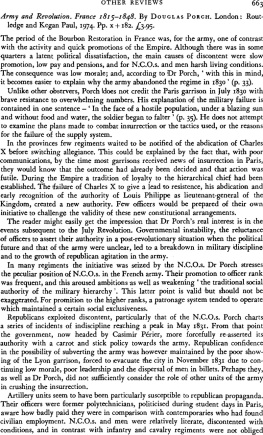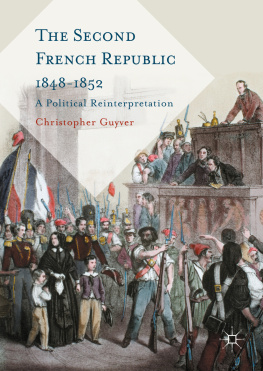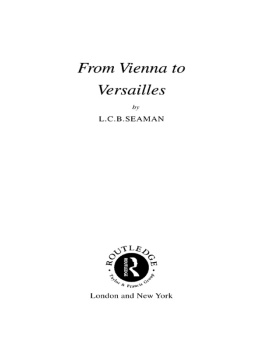First published in 1974 by Routledge & Kegan Paul Ltd
This edition first published in 2022
by Routledge
4 Park Square, Milton Park, Abingdon, Oxon OX14 4RN
and by Routledge
605 Third Avenue, New York, NY 10158
Routledge is an imprint of the Taylor & Francis Group, an informa business
1974 Douglas Porch
All rights reserved. No part of this book may be reprinted or reproduced or utilised in any form or by any electronic, mechanical, or other means, now known or hereafter invented, including photocopying and recording, or in any information storage or retrieval system, without permission in writing from the publishers.
Trademark notice: Product or corporate names may be trademarks or registered trademarks, and are used only for identification and explanation without intent to infringe.
British Library Cataloguing in Publication Data
A catalogue record for this book is available from the British Library
ISBN: 978-1-032-12623-4 (Set)
ISBN: 978-1-003-26095-0 (Set) (ebk)
ISBN: 978-1-032-12822-1 (Volume 2) (hbk)
ISBN: 978-1-032-12824-5 (Volume 2) (pbk)
ISBN: 978-1-003-22636-9 (Volume 2) (ebk)
DOI: 10.4324/9781003226369
Publishers Note
The publisher has gone to great lengths to ensure the quality of this reprint but points out that some imperfections in the original copies may be apparent.
Disclaimer
The publisher has made every effort to trace copyright holders and would welcome correspondence from those they have been unable to trace.
First published in 1974
by Routledge & Kegan Paul Ltd
Broadway House, 68-74 Carter Lane,
London EC4V 5EL and
9 Park Street,
Boston, Mass. 02108, U.S.A.
Printed in Great Britain by
The Camelot Press Ltd, London and Southampton
Copyright Douglas Porch 1974
No part of this book may be reproduced in any form without permission from the publisher, except for the quotation of brief passages in criticism
ISBN 0 7100 7460 3
Library of Congress Catalog Card Number 73-87317
To my parents
Contents
Preface and acknowledgments
Abbreviations
Introduction
2 The Restoration army, 1824-30
3 1830
4 Casimir Prier and the politics of stability
5 The Soult law
6 LArme Savante: Republicanism in the artillery
7 The Droits de lHomme
8 Lunville, 1834
9 Professional revolutionaries and secret societies, 1835-7
10 Strasbourg, 1836
11 Conclusion
Appendix I Ministers of War, 1815-48
II Regiments reported for republican activity, 1830-44
III Garrisons and garrison towns
IV Soldiers and NCOs arrested for republican activity, 1830-48
V Officers reported to the War Minister for republican activity, 1830-48
VI By-laws of the Socit Philanthropique des Francs Amis
Maps 1 Conscript literacy, 1827-9
2 Distribution of Protestants in France, 1824
3 Republican activity in the army, 1830-40
Notes
Bibliography
Preface and acknowledgments
This book is a study of politics in the metropolitan French army between 1815 and 1848. It is concerned both with grass-roots political dissent and with day-to-day problems confronting soldiers of all ranks. I have tried to place political militancy in the army in the broader historical context of post-1815 France and to examine the military reforms instituted in reaction to it.
The Algerian army is not considered in this work because the catalysts for political activity in France namely civilian republican agents were not present in Africa. Consequently, Algeria was virtually free of political activity. In the only two military mutinies there, both in the same regiment, the soldiers demanded no political solution beyond the immediate redress of their grievance: freedom for a comrade accused of insulting an Arab noblewoman in 1833 and restoration of an extra pay allowance in 1834.1
I owe my thanks to the Master and Fellows of Corpus Christi College, Cambridge, for research grants which enabled me to complete my work. I should also like to thank those in England and France who have given me advice and encouragement over the last three years: especially the late Dr David Thomson, Mr J. P. T. Bury, Professor Louis Girard, Dr Christopher Andrew, Professor Douglas Johnson, and Gillian Flint.
Abbreviations
AEPArchives de lEcole PolytechniqueAHGArchives Historiques de la Guerre, Chteau de VincennesANArchives NationalesAPArchives Parlementaires
Introduction
The Restoration and the army were inherently opposed right from the start.1 Seventy-five years later, Guillons conclusion needs substantial reconsideration. Political opponents of a Bourbon Restoration undoubtedly existed in the army, which was still dazed by its Waterloo defeat. But military opposition to the Bourbons cannot be attributed only to the traditional political enmity of the Empire for the ancien rgime.
The Restoration, it is true, declared war on an army that had deserted it in the hundred days. An ordinance of 16 July 1815 disbanded the Imperial army which, under Davout, had retired beyond the Loire as the allies approached Paris. Only the 16,000-man Strasbourg garrison disobeyed, demanding back-pay. The army dispersed, the government ignored earlier promises and accused nineteen officers who had rallied to Napoleon in the hundred days of treason. Colonel La Bedoyre, the first to lead his regiment into revolt, was executed on 19 August. Marshal Ney, the bravest of the brave, fell before a firing squad in Paris, while General Mouton-Duvernet was executed in Lyon and General Chartran at Lille. Several generals, including Belliard, Berton, Cambronne, Debelle, Decaen, Drouot, Dufour and Orano, were jailed and others exiled.
General Marmont, who had followed Louis XVIII to Ghent during the hundred days, protested against these harsh reprisals: Unjust, deadly and absurd consequences will surely be the result.2 Baron Pasquier echoed Marmot: These examples... far from producing the desired effect, put a large number of soldiers in a vengeful mood and resulted in a number of conspiracies.3
In the south white terrorists attacked returning veterans; Marshal Brune was shot at Avignon and General Ramel at Toulouse, while soldiers of the 13th Infantry Regiment were massacred at Nmes. Others were beaten or jailed.4 Major Barres, sailing from Brest to Bordeaux to avoid the terrorists, noted that veterans met only hostility in the south.5
In Paris a commission convened in October 1815 to examine the conduct of officers during the brief return of the usurper, and Marshal Clarke zealously scaled down the mammoth Napoleonic armies to a size acceptable both to the allies and to the Bourbons. More than 15,000 officers had been dismissed and in part replaced by migrs of limited experience and ability when the ex-Napoleonic Marshal Gouvion-Saint-Cyr took over the War Ministry in 1817.6












